
Publisher:
Bonnie King
CONTACT:
Newsroom@Salem-news.com
Advertising:
Adsales@Salem-news.com

~Truth~
~Justice~
~Peace~
TJP
Nov-05-2013 19:44

 TweetFollow @OregonNews
TweetFollow @OregonNews
BETRAYAL: Toxic Exposure of U.S. Marines, Murder and Government Cover-up - Costa Rica Sun
Robert O'Dowd Salem-News.com“Colonel Sabow’s death could not have been a suicide but had to have been a homicide inflicted by the hands of another.” - Michael A. Jacobs, former Orange County prosecutor
 Courtesy: freedomsphoenix.com |
(SAN JOSE) - This is our first segment and installment in our New Drug War series.
With Costa Rica playing a key role throughout the years from Iran Contra Affair and Barry Seals and US Government involvement in aiding and abetting, and covering up, with a trail of bodies of journalists, players and innocent bystanders, being left in the midst to the present, where more are expected to come, as the war rages on and corruption of those who are involved and death of those fighting against it and those silencing the opposition and those who expose their criminal organization and network..
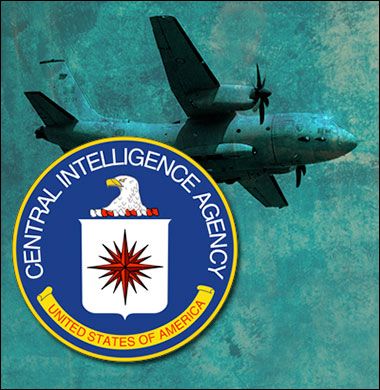 |
The article draws from work by Salem-News.com's Robert O'Dowd, Borderland Beat Reporter un vato and El Diario de Coahuila (10-13-13) Proceso (10-12-13) by Luis Chaparro and J. Jesus Esquivel.
Six years after Kiki, a former Marine and DEA agent, was murdered in Mexico, Col. James E. Sabow was murdered at Marine Corps Air Station, El Toro, California, because he was a threat to blow the whistle on the use of El Toro to service CIA proprietary C-130’s to fly cocaine into the US.
Tim King, Salem-News.com, and I published BETRAYAL: Toxic Exposure of U.S. Marines, Murder and Government Cover-up on Amazon in Sept. 2013.
BETRAYAL reports on the exposure to environmental contaminants at El Toro and Camp Lejeune and most alarming of all, the murder of Marine Colonel Sabow and other Marines whose deaths are tied to use of El Toro’s assets during the 1980s and 1990s to import South American cocaine into the U.S and to export guns to the Contra Rebel faction of Nicaragua.
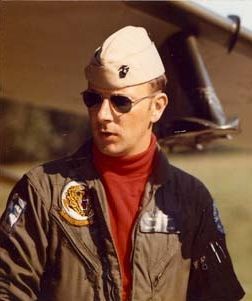 Colonel James Sabow USMC |
Demanding a court martial to clear his name of false charges of misuse of government aircraft, which threatened to blow the whistle on the use of El Toro’s assets to support narcotrafficking, Colonel Sabow was found dead on his patio by his wife on January 22, 1991.
The government called his death a suicide, but don’t believe it.
The use of CIA proprietary airlines to fly weapons and supplies to the Contras in Central America and illegal drugs into the US could not have been done without the knowledge and cooperation of others outside of the Marine Corps. This was not a rouge operation run by a couple of unscrupulous officers. The CIA, DEA and the highest levels of government had to know about these flights. These aircraft could not have flown across the US border without the government’s approval. Headquarters Marine Corps had to know about the use of the base to support civilian aircraft (e.g., refueling) flying weapons and supplies to the Contras. But, the Contra War had ended in June 1990; there was no longer a need to continue shipments to the Contras.
With his reputation as no nonsense, straight arrow Marine, the threat to those involved in narcotrafficking was that Colonel Sabow would refuse to go quietly into retirement. If charges of personal misuse of government aircraft were formally made, his insistence on a court martial rather than plead guilty to Article 15 charges, had unintended consequences: Once he found out about the illegal drug shipments, he would have reported the activity, which would have resulted in a criminal investigation, indictments and scandal to the government. He had to be stopped. [i][i]
FRAUDULENT AUTOPSY PHOTOGRAPH
The death of Marine Colonel Sabow took a new twist with the discovery of a fraudulent autopsy photograph by Bryan Burnett in the death investigation report submitted to the House Armed Service Committee by DOD. Burnett reported the ‘doctored autopsy photo’ was initially provided in discovery by the United States Department of Defense in 1993, used for trial in Federal Court (Central District of California, SA CV 93-991) and submitted in an investigative report on the death of Colonel Sabow to the United States Congress in November 2004.[ii][ii]
 |
The ‘doctored autopsy photo’ was included in an official report submitted by Jon J. Nordby, Ph.D., Final Analysis and Forensics, entitled, “Colonel James E. Sabow, Death Investigation & Evidence Analysis,” dated November 7, 2004. The Nordby report was submitted to Mr. John Awtrey, Director, Law Enforcement Policy and Support, Office of Undersecretary of Defense, Mr. Charles Abell, Assistant Secretary of Defense, and Congressman Henry Hyde, Chair, The House Armed Services Committee. Nordby’s investigation was completed under Federal Contract HQOD95-04-C-0022.
According to both Dr. Sabow and Burnett, the Nordby report (provided to DOD) erroneously stated that, “Clearly here there is no evidence of injury on the right side of the neck below the right ear. Again, the swelling observed is a result of the displaced skull fractures and the soft tissue injuries which are in turn the result of the shot gun discharge into the decedent’s mouth. No soft tissue injuries support the view that the decedent was struck a blow to the back of the head or to the area below the right ear. There are no soft tissue injuries which have their origin from outside of the skull or from the outside surface of the surrounding tissues.”
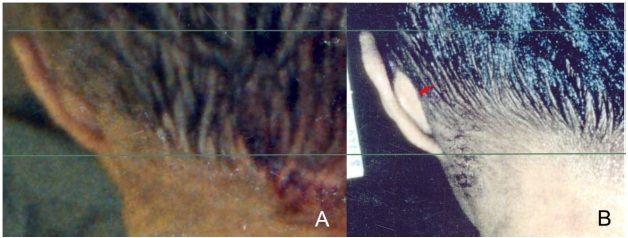 |
 |
In 2012, Dr. Sabow demanded that the Orange County Sheriff/Coroner provide him a full set of the autopsy photos. He made a startling discovery. The photo of the back of Colonel Sabow’s head that the DOD and Nordby presented in their official reports to the United States Congress was an indeed doctored photo as discovered by Burnett.
The original autopsy photo showed a huge swelling involving the entire right occiput and which extended inferiorly involving the entire right side of the neck. The following head photo also shows the depression concavity on the right side of the head from the force of a blunt object used to render Colonel Sabow unconscious, barely breathing and with only minutes left to live.
In addition, the photo depicts a swollen purplish ear known as Battle’s Sign that resulted from a basilar skull fracture that could only have occurred before he was shot. The massive swelling on the right side of the head is clearly visible. This photo appears to have been taken after the body was cleaned and prior to the autopsy.
The circumstances surrounding his death and the forensic evidence from the crime scene support murder by a government assassination team, crime scene tampering and government cover-up at the highest levels, including a ‘doctored autopsy photograph’ submitted in a Defense Department report on the death of Colonel Sabow to Congress in 2004. An affidavit in 2010 to the Naval Criminal Investigative Service (NCIS) by an internationally renowned pathologist reported homicide and crime scene tampering. The pathologist orally withdrew the affidavit. The 2010 NCIS cold case investigation dismissed homicide as the manner of death, reaffirmed the false charges of misuse of government aircraft, depression and suicide as the manner of death.
Colonel Sabow had no idea that his life was at risk when he made the decision not to plead guilty to false charges of personal misuse of government aircraft. He trusted that these ridiculous charges would be dropped at a court martial and other Marines to ‘always have his back.’ He didn’t know that his decision was a threat to those involved in the illegal narcotrafficking of cocaine into the US.
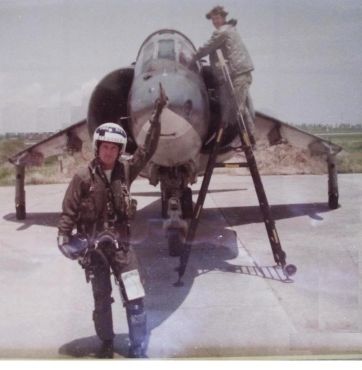 |
In January 1991, the air war in Desert Storm was underway and Colonel Sabow was watching the news on T.V. when his wife decided to attend Mass in a nearby Catholic church. Sara Sabow told her husband that she was late for church but, if she left now, would be able to receive communion. Just before she left, the telephone rang three times but when her husband answered each time, no one was on the other end. She heard the escalating irritation in her husband’s voice, “Colonel Sabow, this is Colonel Sabow…pause, Colonel Sabow.” She turned and hurried to the car for the short drive into Santa Ana. Little did she know then, that these were the last words she would ever hear husband utter.
Colonel Sabow had been relieved of his duties by the Brigadier General Wayne Adams, Commanding General, MCAS El Toro, pending an investigation of personal misuse of government aircraft. Colonel Sabow had the option of accepting nonjudicial punishment by the BG Adams (Article 15) for something he had not done or requesting a court martial to clear his name, if formal charges were filed. He made it known that he was not guilty of misuse of government aircraft and would request a court martial, if necessary.
Something more than an allegation of personal misuse of aircraft had caused the Marine Corps Inspector General’s visit to El Toro just before the start of the Gulf Air War. Colonel Sabow had no idea of the real purpose of the IG’s visit, but it definitely had nothing to do with misuse of government aircraft.
On Tuesday morning, January 22nd, Colonel Sabow had followed his practice of placing the TV on mute when expecting a visitor. After Sara Sabow left for church, someone had made the fourth telephone call. He had been watching the major media news coverage of the situation in the Persian Gulf since wake-up. Someone had called and he was expecting a visitor.
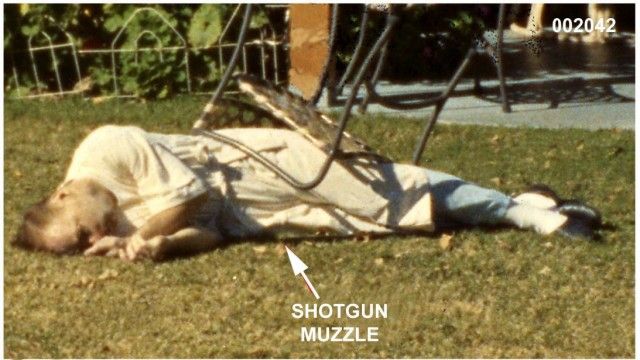 |
After he placed the television on mute, he arose from his easy chair, and left his house through the patio door. He walked the length of the patio, called the dogs, which were in the back yard and enclosed them in the garage.
Colonel Underwood, his next-door neighbor, or an unexpected visitor may have been the caller. Colonel Underwood was deathly afraid of Colonel Sabow’s German shepherds and always phoned Sabow before visiting him. Otherwise the dogs spent their entire day in the backyard or in the house. The only thing that is certain is that Colonel Sabow had no clue that his life was at risk.
Sometime between 0830 and 0900 on January 22, 1991, an unsuspecting Colonel Sabow, decorated Vietnam fighter with 221 combat missions and by all accounts, the definition of a straight arrow Marine, with 28 years of service, met his death at the hands of others.
He was not armed with a side arm; he didn’t consider his life threatened; El Toro was a secured base. But, his knowledge of the illegal narcotrafficking and the possibility that others thought this information could be disclosed to the media was a threat.
His reputation as a straight arrow Marine and request for a court martial to fight false charges of personal misuse of government aircraft were taken seriously by those involved in narcotrafficking. The disclosure of the use of former military aircraft to transport weapons to Central and South America and, return to the US with kilos of cocaine, the fuel for the crack cocaine epidemic, would have been a major media news story, leading to a criminal investigation and prosecution of those involved. The Marine Corps could not have avoided the inevitable Congressional inquiries. The Marine Corps’ Ribbon Creek drowning would have paled in comparison.
Was he met by strangers when he opened the door to his quarters on Fifth Street; taken totally by surprise and unarmed; no way to resist and no place to run? If he had a side arm, he may have had time to get off several shots; maybe even take down one or more of the killers.
The unexpected blow to the right side of the head was violent, resulting in unconsciousness. He was still alive on the ground but not for long. The blow caused a massive depressed occipital skull fracture along with one or more fractures extending through the base of his skull (basilar skull fractures). Occipital skull fragments penetrated into the back of Colonel Sabow’s brain. He was near death due to the massive brainstem trauma in which agonal hyperventilation characteristic of this type of injury occurs. The colonel was aspirating blood from a wound in his pharynx that resulted from a basilar skull fracture. In fact, the tracheae, bronchi, bronchioles and alveoli were filled with blood, doubling the weight of the right lung. There was swelling behind the right ear covering the back of the skull.[i]
Colonel Sabow was taken by surprise by several assailants, struck with a violent blow to the head, which caused a loss of consciousness. While lying on the ground in his backyard, the assailants secured the shotgun from his bedroom, forced the weapon into the mouth of the unconscious Marine and discharged it. Someone with knowledge of the Sabow house knew where he stored the shotgun.
According to Dr. David Sabow, his younger brother and a board certified forensic neurologist, Colonel Sabow first learned that former military aircraft transferred to the CIA proprietary airlines were flying illegal drugs into the US the night before he was killed. Dr. Sabow told us that:
Colonel Underwood told Col. Sabow (on the day before he was murdered) that the C-130s were not simply transporting weapons but were returning from Central America and Mexico with drugs. Sabow threatened Underwood and told him that he would not tolerate this and he would divulge all that he knew. In fact, Col. Sabow called his retired mentor, Assistant Commandant of the Marine Corps, General J.K. Davis on the night before he died and told Gen. Davis what he was about to do.[ii]
An International Response Team (“IRT”) team[iii] was mobilized out of San Diego and Colonel Sabow was assassinated the following morning. Orders, presumedly originating from Washington, were to defy DOD (SECNAVINST) regulations and send his body to Orange County Sheriff/Coroner rather than to the nearby Balboa Naval Hospital for post mortem examination.
The Orange County Medical Examiner determined the manner of death as suicide. Despite my profession as a board certified neurologist and involved in forensic neurology, Dr. Singhania refused to discuss the findings with me. It was over one year before I received the autopsy report. Prior to seeing the autopsy report, I had serious suspicions that Col. Sabow was murdered. This was based on sound circumstantial evidence. But after studying the post mortem findings and subsequently reviewing autopsy and crime scene photos, I knew beyond a doubt that Col. Sabow had been murdered. I also knew that there was an extensive cover-up. (It did not take a board certified neurologist to come to this conclusion). Anyone with a modicum of common sense would know that the manner of death was homicide.[iv]
ORANGE COUNTY ATTORNEY
Michael A. Jacobs, retired attorney and former supervisor of the Homicide Trials Division, Orange County District Attorney’s Office, said the evidence supported homicide as the manner of death. As an attorney for the Orange County District Attorney, Jacobs reviewed 300 to 400 homicides, “including probably a dozen cases which were classified as suicides.” [v]
Jacobs wrote to Congressman Duncan Hunter on December 24, 2006. Jacobs said there’s no question that homicide and not suicide was the manner of death. Jacobs cited the compressed fracture to the right occipital skull and resulting hemorrhaging beneath the scalp and the large amount of aspirated blood found in the alveoli of Colonel Sabow’s lungs.
Dr. Sabow provided copies of forensic medical evaluation reports, x-rays, and autopsy and coroner reports to Jacobs. Jacobs told Hunter that, “from my experience, I do not see a logical, or more importantly, a scientifically acceptable medical explanation of the above facts other than which I have indicated.” Jacobs was clear. The facts supported homicide as the manner of death, not suicide.
Jacobs told Congressman Hunter that the compressed skull fracture to the occipital skull was an inward fracture that could not have been caused by a shotgun blast to Colonel Sabow’s mouth. Jacobs cited the autopsy photographs which showed significant bleeding beneath the scalp, resulting in the formation of a large blood clot. This supports that Colonel Sabow had to be alive at the time the blow was inflicted and for some time thereafter.
Jacobs concluded that this type of injury could only have been inflicted by a blunt force trauma and not by a self-inflicted shotgun blast.
As to the aspirated blood in the lungs, Jacob told Congressman Hunter that the shotgun blast to the mouth blew away the colonel’s brainstem and the capability to take another breath. The blow to the head left him seriously injured but able to breathe for some time. Lying on his right side on the ground, his right lung began to fill with blood. He only had minutes to live.
Other factors supporting homicide cited by Jacobs included: the absence of the Colonel Sabow’s fingerprint evidence on the shotgun, gunshot residue test results, blood splatter evidence, the positioning of the body, the shotgun and the patio chair at the crime scene.
Jacobs’s conclusion was that, “Colonel Sabow’s death could not have been a suicide but had to have been a homicide inflicted by the hands of another.” Jacobs boss was not interested in pursuing a homicide investigation.
NOTES:
[i] He was near death due to the massive brainstem trauma in which agonal hyperventilation characteristic of this type of injury occurs: Interview with Dr. David Sabow who has conducted extensive scientific analysis of the pathology of his brother’s murder.
[ii] General J.K. Davis: Dr. Sabow’s theory is that General Davis initiated the order to kill Colonel Sabow after the lengthy telephone call between the two Marine officers the night before Colonel Sabow was murdered. There is no evidence that this actually occurred. It’s possible that Colonel Sabow’s phone was tapped and that others who learned of his insistence on fighting the unsupportable charges of personal misuse of aircraft even after learning of the narcotrafficing activity decided to order the murder.
[iii] IRT team: In a series of emails and telephone interviews, Dr. David Sabow told us that Bill Taylor, a former Marine and investigator working for him but through Dan Sheehan, received information from a Pentagon contact. A meeting was arranged with a source that was stationed at Camp Pendleton. Taylor was given access to computer records, which indicated that on January 22, 1991 the helicopter that made the routine daily rounds of Marine and Naval bases carried four men from Pendleton to El Toro. These were members of an IRT team (International Response Team). The helicopter that routinely landed next to the tower at El Toro, on that day landed across the airfield at a point that was nearest to the Colonel’s housing. The four men got out and then the helicopter flew over to the tower. This all took place around 0800.
[iv] Colonel Sabow first learned that former military aircraft transferred to the CIA proprietary airlines were flying illegal drugs into the US the night before he was killed: Email from Dr. David Sabow.
[v] Letter to Congressman Duncan Hunter on December 24, 2006: Letter from Michael A. Jacobs was obtained from Dr. David Sabow.
Follow these topics: Drug War
 Bob O’Dowd is a former U.S. Marine with thirty years of experience on the east coast as an auditor, accountant, and financial manager with the Federal government. Half of that time was spent with the Defense Logistics Agency in Philadelphia. Originally from Pennsylvania, he enlisted in the Marine Corps at age 19, served in the 1st, 3rd, and 4th Marine Aircraft Wings in 52 months of active duty in the 1960s. A graduate of Temple University, Bob has been married to Grace for 31 years. He is the father of two adult children and the grandfather of two boys. Bob has a blog site on former MCAS El Toro at mwsg37.com. This subject is where Bob intersected with Salem-News.com. Bob served in the exact same Marine Aviation Squadron that Salem-News founder Tim King served in, twenty years earlier. With their combined on-site knowledge and research ability, Bob and Tim and a handful of other ex-Marines, have put the contamination of MCAS El Toro on the map. The base is highly contaminated with TCE, trichloroethelyne
Bob O’Dowd is a former U.S. Marine with thirty years of experience on the east coast as an auditor, accountant, and financial manager with the Federal government. Half of that time was spent with the Defense Logistics Agency in Philadelphia. Originally from Pennsylvania, he enlisted in the Marine Corps at age 19, served in the 1st, 3rd, and 4th Marine Aircraft Wings in 52 months of active duty in the 1960s. A graduate of Temple University, Bob has been married to Grace for 31 years. He is the father of two adult children and the grandfather of two boys. Bob has a blog site on former MCAS El Toro at mwsg37.com. This subject is where Bob intersected with Salem-News.com. Bob served in the exact same Marine Aviation Squadron that Salem-News founder Tim King served in, twenty years earlier. With their combined on-site knowledge and research ability, Bob and Tim and a handful of other ex-Marines, have put the contamination of MCAS El Toro on the map. The base is highly contaminated with TCE, trichloroethelyne
You can email Bob O’Dowd, Salem-News.com Environmental and Military Reporter, at this address: consults03@comcast.net
 |
 |
 |
Articles for November 4, 2013 | Articles for November 5, 2013 | Articles for November 6, 2013




Salem-News.com:

Terms of Service | Privacy Policy
All comments and messages are approved by people and self promotional links or unacceptable comments are denied.
[Return to Top]
©2026 Salem-News.com. All opinions expressed in this article are those of the author and do not necessarily reflect those of Salem-News.com.